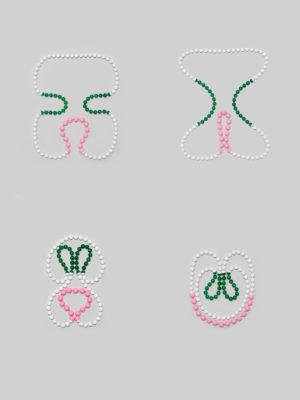
The humble bead! We owe it all to them, those tiny little beings with holes through their hearts, those utterly simplistic carriers of meaning too often relegated to the realms of meaningless kitsch or outdated history.
Beads are among the oldest objects known to have been made: as early as 70,000–90,000 years ago, shells were drilled and worn as beaded necklaces, to be traded and gifted. Whether linked to commercial transactions, used as currency in the afterlife, or utilised as part of religious rituals, beads are an undeniable part of the human story.
Unfortunately, it is precisely their ubiquity that has made them seem banal and unimportant. When we see beads, we often think of children fusing Perler beads into the shape of a dinosaur or of cheesy giftshop keychains. Beaded breathes life back into this history-laden material by presenting nine international artists who, at some point in their career, explored beads as tiny tools for communication.


CURRENT OBSESSION
What are the intentions of the exhibition in terms of the selection of artists and the specific techniques discussed?
CATARINA SILVA (CS)
The exhibition Beaded brings to light a material charged with history and symbolism, enhancing its possibilities and avoiding the banalisation and stigmatised conception that it has been subject to over the centuries.
Choosing the material itself as the title for this group show communicates an intent to question the identity, place and potential of contemporary jewellery in its material diversity and technical vocabulary.
I have chosen a group of artists whose works I admire, encompassing different countries and continents, through different cultures and aesthetics, in order to present to the public the plastic and conceptual potential of beads.
CO
Beads and beadwork are known and regarded as overly feminine, and sometimes as ‘hobbyist’, and I was wondering if the exhibition tackles, disproves, or approves of those assumptions in any way?
CS
I am aware of the ‘hobbyist’ and feminine-labour relation that the general public relates to when thinking about beads and beadwork, and my intention is to challenge the visitors to face this misconception and cross that borderline while questioning and problematising the status of this primordial and timeless material.


CO
Could you tell me about the list of artists? What brings this group together?
CS I have been working with and about beads for quite some time now, and when studying and investigating this subject I came across and selected this group of artists (some I have known for quite a long time and others were true revelations) who share a similar passion through different interpretations.
Caroline Broadhead searches for balance between substance and image, presence and absence with a lyrical and intimate approach.
Daniel Kruger, inspired by the beading work of the Ndebele women from South Africa, brings up a series of elegant cylindrical pendants/necklaces that captivate us with their precious surfaces and sensual, flexible movements.
Felieke van der Leest uses fairy-tale-like imagery that strives to strike the viewer with serious themes, ironising conventional jewellery.
Joyce J. Scott’s work prods the viewer to question social and political stereotypes.
Manon van Kouswijk shows some of her artist publications, which are a fundamental part of her conceptual thinking and of her approach, itself rooted in historical archetypes for contemporary making.
Sari Liimatta works with people’s interactions with animals and other human beings, acting like a reporter, documenting stories that aim to produce a change in how we act on environmental issues.
Sébastien Carré mixes a wide range of materials to create colourful structures that look at once like cosmic landscapes and living organisms similar to bacteria.
WALKA Studio founders, Nano Pulgar and Claudia Betacourt, take a trip back in time to pre-Columbian civilisations to approach the tradition of bead necklaces passed down from mother to daughter, reminding us of how important cultural heritage is in the twenty-first century.
I (Catarina Silva) have been developing a series of votive pieces with ritualistic and contemplative characters – similar to reliquaries – as a way to archive memories that I have collected over time.


CO
Why do you think it’s important to show your work during MJW?
CS
Showing at Munich Jewellery Week is a fundamental step for an artist and an important experience in itself. It is challenging to say the least and is a way to interact with an international art scene.
Collaborating on an event marked by a huge diversity of artists, jewellers, collectors and gallerists enables a rich exchange of ideas and projects. This event is the centre of the contemporary jewellery scene. It is in fact the most interesting place to be!

This article was published in the online edition of Munich Jewellery Week 2020
BEADED
Caroline Broadhead, Catarina Silva, Daniel Kruger, Felieke van der Leest, Joyce J. Scott, Manon van Kouswijk, Sari Liimatta, Sébastien Carré & Walka Studio
Institut Français
Kaulbachstraße 13, 80539 München, Germany
Welcome drink 12.03 17:00-21:00
11.03 – 15.03 Wed 11:00-19:00
Thu 11:00-21:00
Fri-Sat 11:00-19:00
Sun 14:00-19:00





